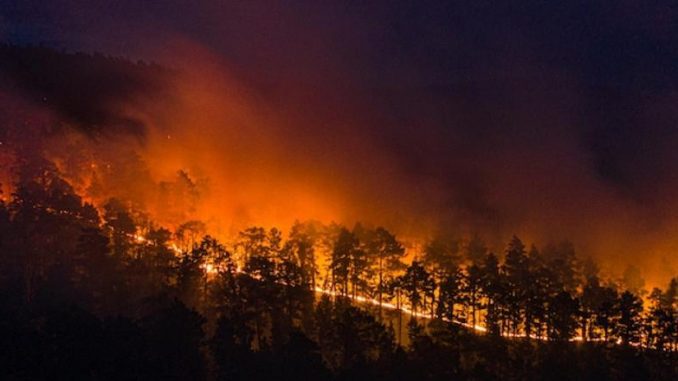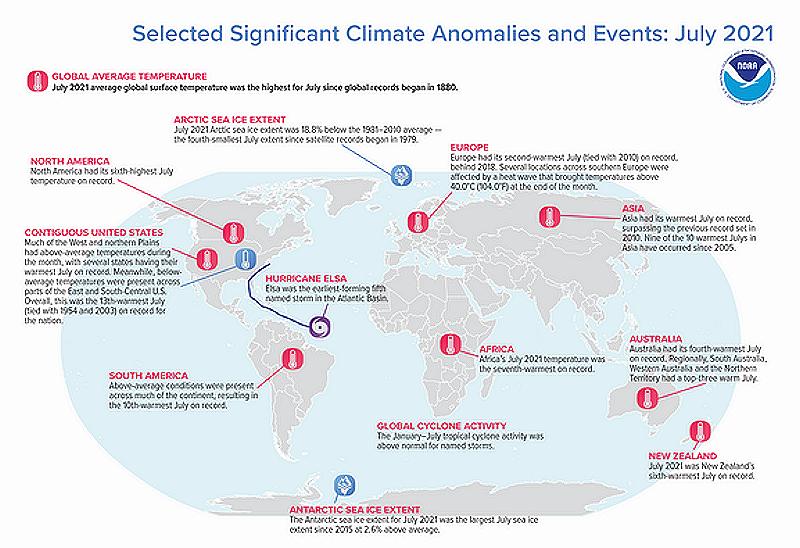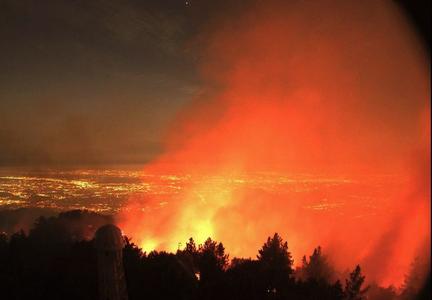
ASHEVILLE, North Carolina, August 13, 2021 (ENS) – July 2021 was the hottest month ever documented on this planet since recordkeeping began 142 years ago, according to new global data released today by NOAA’s National Centers for Environmental Information.
“In this case, first place is the worst place to be,” said NOAA Administrator Rick Spinrad, PhD, an ocean, atmosphere, and climate science and policy expert and former NOAA chief scientist. President Joe Biden selected him to run NOAA.
“July is typically the world’s warmest month of the year, but July 2021 outdid itself as the hottest July and month ever recorded,” Dr. Spinrad said. “This new record adds to the disturbing and disruptive path that climate change has set for the globe.”

The National Oceanic and Atmospheric Administration, usually called NOAA, is an American scientific and regulatory agency within the U.S. Department of Commerce that forecasts weather, monitors oceanic and atmospheric conditions, charts the seas, conducts deep sea exploration, and manages fishing and protection of marine mammals and endangered species in the U.S. exclusive economic zone.
This past July, extreme heat and global climate change showed itself in a wide range of ways around the globe – floods, heatwaves, drought, hurricanes, wildfires and loss of glacial ice.
July 2021 Has the Numbers to Prove It
Globally: the combined land and ocean-surface temperature was 1.67 degrees F (0.93 of a degree C) above the 20th-century average of 60.4 degrees F (15.8 degrees C), making it the hottest July since records began 142 years ago.
It was 0.02 of a degree F (0.01 of a degree C) higher than the previous record set in July 2016, which was then tied in 2019 and 2020.
The Northern Hemisphere: the land-surface only temperature was the highest ever recorded for July, at an unprecedented 2.77 degrees F (1.54 degrees C) above average, surpassing the previous record set in 2012.
Regional records:
- Asia had its hottest July on record, besting the previous record set in 2010;
- Europe had its second-hottest July on record – tying with July 2010 and trailing behind July 2018;
- North America, South America, Africa and Oceania all had a top-10 warmest July.
These facts were gathered by the National Centers for Environmental Information, NCEI, an agency of the United States government. NCEI manages one of the world’s largest archives of atmospheric, coastal, geophysical, and oceanic data, containing information that ranges from the surface of the Sun to Earth’s core, and from ancient tree ring and ice core records to near-real-time satellite images.
NCEI’s Global Annual Temperature Rankings Outlook indicates that, including the data from July 2021, “it remains very likely that 2021 will rank among the world’s 10-warmest years on record.”
This new data has come on the heels of a blistering report on the physical science of climate change from the Intergovernmental Panel on Climate change, IPCC, with scientists from 266 countries contributing data.
“Scientists from across the globe delivered the most up-to-date assessment of the ways in which the climate is changing,” said Spinrad, who said in a statement.
“It is a sobering IPCC report that finds that human influence is, unequivocally, causing climate change, and it confirms the impacts are widespread and rapidly intensifying.”
Extreme heat detailed in NOAA’s monthly NCEI reports is also a reflection of the long-term changes outlined in a major report released this week by the Intergovernmental Panel on Climate Change. https://www.ipcc.ch/report/ar6/wg1/
Sea ice coverage varied by hemisphere: The Arctic sea ice extent for July 2021 was the fourth-smallest for July in the 43-year record, according to analysis by the National Snow and Ice Data Center. Only July 2012, 2019 and 2020 had a smaller sea ice extent.
Antarctic sea ice extent was above average in July — the largest July sea ice extent since 2015 and the eighth highest on record.
The tropics were busier than average: In the Atlantic basin, the season’s earliest fifth-named storm, Elsa, formed on July 1. The Eastern North and Western Pacific basins each logged three named storms. Overall, global tropical cyclone activity this year so far (through July) has been above-normal for the number of named storms.
A map of the world plotted with some of the most significant climate events that occurred during July 2021.
A map of the world plotted with some of the most significant climate events that occurred during July 202 (NOAA NCEI)

Other notable highlights from NOAA’s July global climate report
Sea ice coverage varied by hemisphere: The Arctic sea ice coverage (extent) for July 2021 was the fourth-smallest for July in the 43-year record, according to analysis by the National Snow and Ice Data Centeroffsite link. Only July 2012, 2019 and 2020 had a smaller sea ice extent.
Antarctic sea ice extent was above average in July — the largest July sea ice extent since 2015 and the eighth highest on record.
The tropics were busier than average: In the Atlantic basin, the season’s earliest fifth-named storm, Elsa, formed on July 1. The Eastern North and Western Pacific basins each logged three named storms. Overall, global tropical cyclone activity this year so far (through July) has been above-normal for the number of named storms.
Access NOAA’s July global climate report and images from the NCEI website.
Featured image: Smoke from the Siberian fires is spreading across Russia and in August 2021 reached the North Pole, the first time wildfire smoke has ever touched the Pole. (Photo by Greenpeace International)



